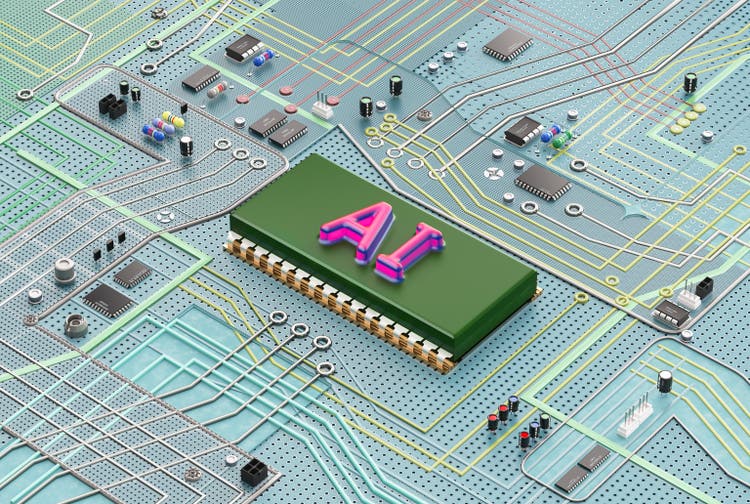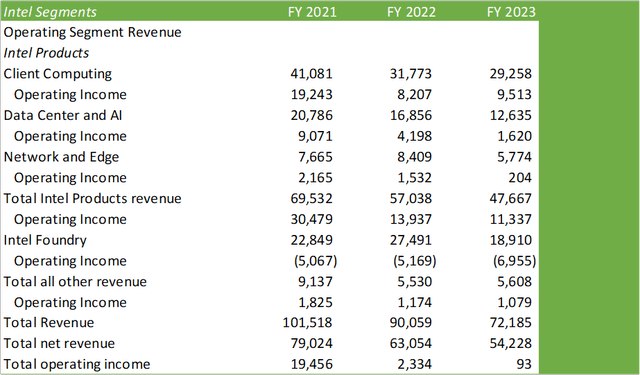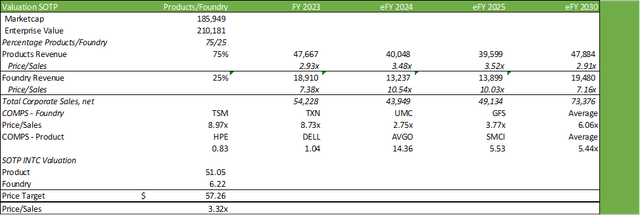Summary:
- Intel has released an updated corporate structure and roadmap, aiming to become the second-largest foundry by capacity by 2030.
- The company plans to segment its Intel Foundry operations into a separate legal entity to attract third-party customers. I believe this may be a bigger challenge than management anticipates.
- Intel will need to prove its ability to meet deadlines with the release and ramp-up of 18A.
Jonathan Kitchen
Intel Corp. (NASDAQ:INTC) recently released its updated corporate structure, reporting segment, roadmap to profitability and growth, and medium-term and long-term foundry targets. This has provided significant visibility into the firm’s profitability across its products and foundry businesses and the results were somewhat eye-opening. With management’s 2030 plan for $15b in customer foundry services revenue, Intel will be positioning itself as the second-largest foundry by capacity. I believe that this ambition will be an uphill challenge as the firm must first gain the trust of customers before attaining next-generation fab services. Given the near-term headwinds in device, networking, and non-AI server, I provide INTC shares a SELL recommendation with a price target of $36.76/share.
Operations
As management had discussed in their FY23 earnings call, Intel will segment out its Intel Foundry operations into its own, separate legal entity. The new entity will include operations focused on process engineering, manufacturing, and foundry services that encompass manufacturing, testing, and assembly to both the Intel Products business and third-party customers. The thought process behind this restructuring is to provide greater visibility into each side of the business to allow for a more appropriate sum-of-the-parts valuation across each segment. I believe that this is also in part related to attaining third-party business as it may create a firewall between Intel Products and Intel Foundry, as the firm’s plan is to focus efforts in what has been dubbed the “post-EUV” era of leading-edge, advanced chip manufacturing. Taking this into consideration, I anticipate that gaining customers’ trust to manufacture their advanced chipsets will be an uphill battle as there are no guarantees of eliminating crosstalk between the two businesses without a complete carveout. Given the secretive nature of the business, guaranteeing the sanctity of customers’ IP will be the top priority in sourcing third-party orders.
I believe another factor Patrick Gelsinger alluded to in the call was that he intends to reduce costs by bringing forth intersegment sales for chip design. I believe that this will make Intel more disciplined in its production process and less inclined to over-producing and building inventory. This will also tally the difference between internal and external business for investors to understand the full scope of where Intel’s chip manufacturing is derived. For internal chip manufacturing, Mr. Gelsinger laid out the goal of insourcing their advanced chip manufacturing, reaching 70% by 2030. He intends on utilizing outside manufacturers for the remaining 30%, which may focus on more of the commoditized nodes vs. the higher-class chipsets, such as the 18A and beyond.
Roadmap For Intel’s Next Generation Chipsets
Mr. Gelsinger laid out the foundation for how he plans to bring Intel back into the dominant position of leading-edge chip design. The plan is for five nodes in four years with the first node anticipated to be manufacturing-ready by the end of 2024. The roadmap for the next generation of chipsets is to have production volumes ramp for the 18A in 2025 with full production capacity in 2026. For internal foundries, the bulk of wafers in 2025 will be derived from Intel 3, Intel 7, and Intel 10. From an investor’s standpoint, I believe Intel needs to prove to the investment community that they can put action behind their words. Though I have no doubts that the firm can scale its 18A chips, I expect that investors will want to see Intel prove that once scaled, margins will improve.
From what I gather from the segment webinar, Intel will be playing catch-up in both design and production for their accelerators. Management mentioned that 2024 will entail a major capital investment to push towards bringing online IDM 2.0, EUV adoption, and bringing the 18A to market. Intel will not be alone in this investment. Through the CHIPS act, Intel will receive $8.5b in grants, $11b in loans, and over $25b in tax incentives to help build their foundries. The EU has committed over $10b to build out their fab as well. Once completed, Intel will be on the clock to staff their facilities, fill capacity, and develop a sales pipeline to compete with the likes of NVIDIA (NVDA) and Taiwan Semiconductor (TSM). I believe 2026 will be the defining point for Mr. Gelsinger to prove that Intel can both design and produce their own chips, as well as produce third-party chips. If the 18A doesn’t scale as expected and if Intel cannot fill foundry capacity, I believe that their five-nodes-in-four-year plan will be a wash. With the ambitious goal of gaining that #2 spot for foundry by 2030, proper execution and timing will be key. In order to get there, management anticipates $25b in capital investments per fab to scale EUV. To take the next step into High-NA, management expects to invest between $25-30b per fab. Both these advanced next-generation processes are expected to bring foundry margins from their current -37% operating margin to 40% and 50%, respectively.
When working out the roadmap to get to $15b in external foundry services revenue, we must first find the starting point. Reading through Intel’s FY23 10-k, the firm is in talks with Tower Semiconductor to provide foundry services at their New Mexico advanced manufacturing facility for 300mm advanced analog processing. The firm also has a definitive agreement with Synopsys to develop IP on Intel 3 and Intel 18A as well as an agreement with ARM to enable chip designers to build optimized compute SoCs on the Intel 18A process. Aside from these strategic partnerships, I cannot uncover any signs that Intel manufactures third-party chip designs in their foundries. With this assumption, I believe the firm will be starting from zero for external customers (If you do know of external 3rd party customers, please leave a comment and I will update the model).
Adding figures behind their ramp-up, I anticipate eFY27 to be the year for breakeven for Intel Foundry as this should coincide with their more advanced chipsets scaling as well as time to acquire external customers for scale. I believe that the firm’s partnership with Tower will be a strong stepping stone to attaining new business. The only pushback I see in this partnership is that the partnership is to manufacture lower-margin, analog chips and will not be utilizing the full, advanced-process capabilities that Intel is seeking to source. I believe a major factor will be whether Intel can get its new foundries in place domestically before Taiwan Semiconductor commences operations domestically. I believe that Intel will either need to front-run Taiwan Semiconductor in deploying domestic capacity or it will require some geopolitical event that will require immediate insourcing of chip manufacturing. I believe that the latter will most likely lead to Intel ramping up capacity as chip designers will be on the clock to nearshore production.
Financial Reporting
As previously reported, Intel faces major headwinds across its business units in returning to growth.
Looking to other operating segments, I anticipate a continued decline into eFY24-25 with eFY26 being the paradigm shift for the return to growth. I anticipate client compute to experience a continued decline despite the release of AI-enabled workstations and laptops. As described in my coverage of Dell (DELL) and Hewlett Packard Enterprise (HPE), I expect devices to continue to slump as a result of tight spending for enterprises and even tighter budgetary constraints on consumers in the face of persistent inflationary pressures. I also expect network equipment to continue the bearish trend through the duration of CY24 before returning to growth. Both Dell and HPE have voiced that non-AI server is recovering; however, I expect this to be a slow burn as enterprises turn their attention to GenAI enablement and cost-savings initiatives.
I expect turning around Intel will be a major uphill battle in the face of the challenging macroeconomic landscape; however, I do believe it to be feasible. Whether Intel will achieve the revenue and margin target laid out is another question altogether; however, given the setup for geopolitical risks and the limited accelerator capacity on the market, Intel does have a fighting chance to achieve its goal of becoming the second-largest foundry by capacity.
Valuation & Shareholder Value
Using Intel’s new segmentation between foundry and products, we can now compare the company on a sum-of-the-parts basis. With the expectation of management achieving their growth goals for Intel, I believe INTC shares can be worth $57.26/share. This is a very long-term valuation target and assumes everything laid out goes according to plan.
For a near-term target, I value INTC shares at $36.75/share. I believe that INTC will be a “show me” story in which the firm will need to prove that they are capable of regaining its leading industry positioning. For their near-term trajectory, I provide INTC shares a SELL recommendation with a price target of $36.76/share at 3.19x price/sales.
Analyst’s Disclosure: I/we have no stock, option or similar derivative position in any of the companies mentioned, and no plans to initiate any such positions within the next 72 hours. I wrote this article myself, and it expresses my own opinions. I am not receiving compensation for it (other than from Seeking Alpha). I have no business relationship with any company whose stock is mentioned in this article.
Seeking Alpha’s Disclosure: Past performance is no guarantee of future results. No recommendation or advice is being given as to whether any investment is suitable for a particular investor. Any views or opinions expressed above may not reflect those of Seeking Alpha as a whole. Seeking Alpha is not a licensed securities dealer, broker or US investment adviser or investment bank. Our analysts are third party authors that include both professional investors and individual investors who may not be licensed or certified by any institute or regulatory body.







